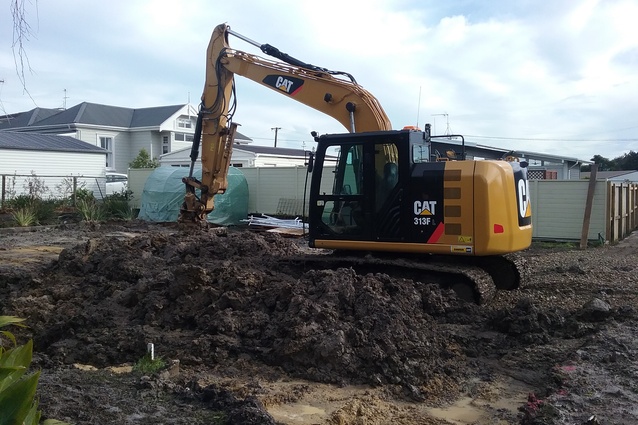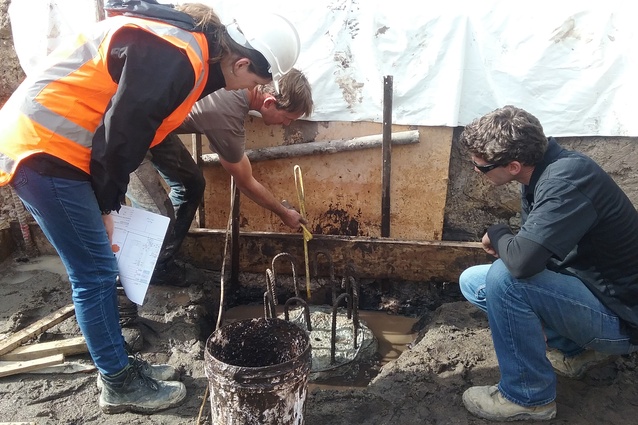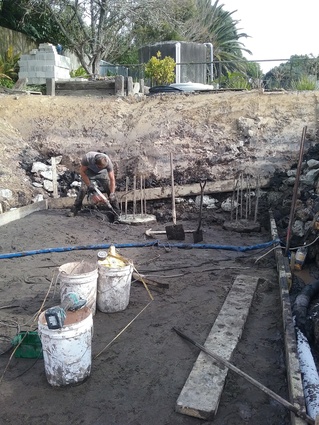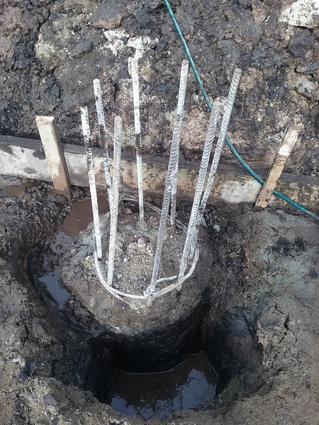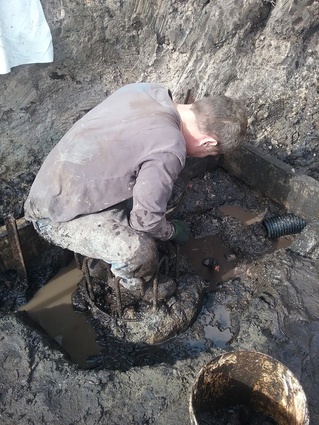The Living House: August edition
Rochelle Payne writes the second blog update on the progress of The Living House, which has thus far proved rather arduous. The rammed earth house in Beachlands is to be the family home of the Paynes, who have decided to target the ‘trifecta’ of sustainability rating tools: Homestar, Passive House and Living Building Challenge.
Now is the winter of our discontent: the Living House of Payne
It’s been a rough few weeks at the Living House. It feels like everything is against us at the moment, including the weather. We finally started piling on site in July, but it has been a hard road getting to that point and it has been difficult to celebrate the wins that have come our way.
It was pretty amazing being granted a Discharge Consent for a greywater system by Auckland Council – as far as I am aware, it is the first one of these granted in a dense urban area that has a sewer connection, which is great news.
Unfortunately, at the same time that we were granted the discharge consent we discovered that we needed $60k worth of piles that we had no consent or design (or money) for, which stopped us being able to start basement construction after the ground breaking party on 30 June. We were so depressed about the piles update that the actual issue of the discharge consent ended up passing us by somewhat!
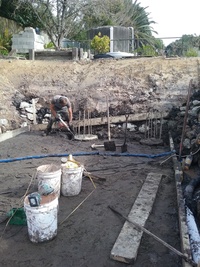
Additionally, while Joel was in Canada at the Sirewall rammed earth course the organisers informed him that we had the design of the house all wrong. They believe that we should have designed the structure as if the house were made from concrete (i.e. rammed earth with strengths and consistency that meet the requirements of concrete), which would get rid of the need for concrete bond beams at the mid floor and the roof.
When I broached that idea with our wonderful engineers at Markplan it didn’t go down well, as it would mean redesigning the house again from scratch, and we had already started piling. We have therefore decided to stick with the current design, as we can’t really afford another 6 month delay and probably an additional $100k in cost for a new design and consents.
After all that, we were rather hoping that the last few weeks were the lowest point for the Living House! However, when we started digging out the basement that didn’t go to plan either. I had hoped that the basement could be dug out in a single day using our amazing local drainlayer and his little yellow digger, but 3 days later we were still digging out a very large hole.
The problem with the Living Building Challenge is that we are not allowed to send any of our construction waste to landfill. Luckily, Joel’s factory landlord had an entire area that he required filled in, so we trucked all of our waste material to that site and used it to fill and level that area. It actually ended up saving us quite a bit of money, as it costs $150 each time you tip at the landfill, although we may have lost that in extra trucking to Clevedon.
That was another 3 days lost in the excavation of the basement and once that was finished, we discovered that the 100mm overpour that the pilers told us that they would do on each pile for safety actually turned out to be 1.5 metres in some instances!

That set us back another 2 days as we had to chip and lug away all the extra concrete. I actually felt like I was Jean Valjean in Les Miserables working on the chain gang, down a deep hole, picking up and moving hunks of rock. It didn’t help that I ended up with gumboot rash after I fell in a muddy hole!
We were furiously racing against the weather clock. It was meant to rain and we wanted to have the basement slab poured before then (Tuesday 1 August), so we could get the block layer in to start building some of the basement walls to help hold up some of the excavation, particularly under the sewer line which is starting to collapse a little bit.
The tanking membrane was delivered to site and Phillipe from Equus took some photos and sent them to the waterproofing contractor, who freaked out and tried to pull out of the job. We managed to convince him that we did know what we were doing and that everything would be ready for the membrane to go down when he arrived.
But of course that didn’t happen! When the waterproofer arrived, all the way from Whangarei, he basically turned around and walked straight off the site in disgust. We realised that he had been expecting nice smooth piles caps to be provided to connect the waterproofing to, however the foundation design of the house didn’t include pile caps, which was a major design disconnect.

The easy solution for that particular problem was to dig out around each of the 6 piles and provide a 100mm wide and 100-150mm deep ring of smooth concrete around each one that the waterproofer can connect to. Easily sorted, even though it has cost us $1,000 for the waterproofer’s wasted time yesterday – money we cannot afford at all.
However, the bigger problem was one that I uncovered when Joel broke away the concrete around the top of 2 of the piles on site – the cages seem to have moved in the pile holes and there was no concrete cover to the reinforcing.
This could have given us another major delay, but in the end was resolved rather easily by digging out 1m of ground around the pile and then back filling it with site-poured concrete to provide the required concrete cover. Phew!
When the waterproofer came back down to do the membrane, however, the concrete was too wet for him to work, so we’ve just spent another $1,000 with no results! As it stands right now we still have a big hole in the ground with no progress on waterproofing or a slab.
On a more positive note, the Living House is currently trying to undertake some advocacy with Auckland Council. Specifically, we have asked them to consider putting in place a policy to:
- Waive consent fees and development contributions for Living Building Challenge-certified houses
- 50 per cent reduction in consent fees and development contributions for 9 and 10 Homestar rated houses
- 25 per cent reduction in consent fees and development contributions for 7 and 8 Homestar rated houses.
We have written an open letter to the Mayor and Auckland Council that you can read on the Living House website and Facebook page and we have also started an online petition that you can sign here.
Read the introduction to the Living House here.

